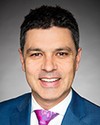Thank you for the opportunity to participate in this meeting.
Discussions on the impacts of pinniped populations often focus on the direct impacts on commercial species. Images of eviscerated cod at the bottom of coves or stomach contents from harvested animals fill our minds.
We must remind ourselves that pinniped impacts are much broader and extend far beyond direct predation. Seals eat fish. Seals eat crab. Seals eat an awful lot of things, to the tune of 1000 to 2000 kilograms per animal, per year. Every item a pinniped consumes is at the expense of some other component of the marine ecosystem. More pinnipeds mean more impacts.
For instance, last week, DFO Newfoundland announced that capelin populations were at critically low levels, driven by challenges in adult survival. Capelin are a key prey for an array of animals, from the iconic northern cod through to cetaceans and pinnipeds.
However, with eight million harp seals sharing the same marine space, capelin have failed to recover, despite a near absence of fishing. This cascades directly into stalled northern cod recovery and the impaired performance of other groundfish stocks.
Is this because seals are eating all the cod? Likely not. Could the eight million metric tons of prey, including capelin, consumed by harp seals annually be preventing the recovery of capelin stocks, thus impairing cod production? This is far more likely.
We hear of other forage fish stocks, such as mackerel and herring, experiencing prolonged periods of low productivity, with many subject to a moratorium. Again, we have a common thread. These forage species are the preferred prey of pinniped populations at historical highs and are being cropped off before they reach other ecosystem components or even sexual maturity. Food webs have been forced to restructure to new and lower productivity states for many commercially important fish species.
The direct and indirect impacts of pinnipeds are easily observed throughout Atlantic Canada. Most groundfish stocks demonstrate higher natural mortality today than in any previous time period, and diets demonstrate an absence of diet items also preferentially selected by pinnipeds, namely large, mid-trophic level forage species such as herring and mackerel. Their absence is manifested in groundfish populations as lower condition estimates, poorer growth, lowered reproductive output and high levels of natural mortality.
We cannot neglect direct impacts. Pinnipeds have annual distributions that strongly overlap with depleted fish stocks. Satellite tagging has shown clear overlap with seasonal cod aggregations. This evidence is later bolstered by direct diet analysis and modelling work, proving the link between pinniped consumption and a high natural mortality in dwindling cod populations in the southern Gulf of St. Lawrence, creating a prognosis of extirpation even in an absence of human-induced mortality.
It is not just marine ecosystems that are vulnerable. Entire riverine food webs can be disrupted by the arrival of a seal herd feeding heavily on whatever fish are locally available, including depleted Atlantic salmon smolts and adults. The arrival of a seal herd becomes synonymous with the denuding of local populations of salmon, trout, sucker and whitefish, and local residents see and will speak of this.
Clearly, the impact of a novel and aggressive piscivore will no doubt trickle down through the entire system to some new and unexpected stable state far different from where it began. Our challenge is to translate pinniped populations to ecosystem impacts. Comparing pinniped consumption with other ecosystem components at a landscape level misrepresents the problem, as the greatest impacts are often local, driven by overlap in both time and space.
Disentangling the role of pinnipeds in the ecosystem means a thorough appreciation of diets and distribution across the entire year, and not just within short snapshots. Only then can we speak with certainty about the role they play, how they may impact surrounding trophic levels, and how the system may respond to lower pinniped abundance.
Our current understanding is heavily restricted both spatially and temporally, creating severe biases in interpretation. For instance, how can we speak to pinniped diets, when sampling is heavily spatially biased to represent only a small portion of the pinniped herd itself?
We must acknowledge that if pinniped consumption were reduced from current levels, other ecosystem components would have additional resources, and some would perhaps experience growth. Cod is an example. Determining the strength of this response is predicated on precision around our understanding of pinniped impacts and the greater ecosystem.
Finally, if we are to accept that the role of pinnipeds in the marine ecosystem will continue at current population levels, we must accept that many of our fish stocks will also persist at lower total levels and productivity than historically observed and will be unable to rebuild to historic levels under any conditions.
This period of pinniped overabundance now represents the new normal. Stocks cannot be rebuilt with the current ecosystem structure favouring pinnipeds. This must be incorporated into rational, modern reference points and rebuilding plans commensurate with the current expectations of productivity, as many depleted fish stocks may actually be considered fully rebuilt under the current level of predation and productivity offered by pinniped populations at current levels.
Thank you again for this opportunity, and I look forward to addressing any questions from this esteemed committee.










